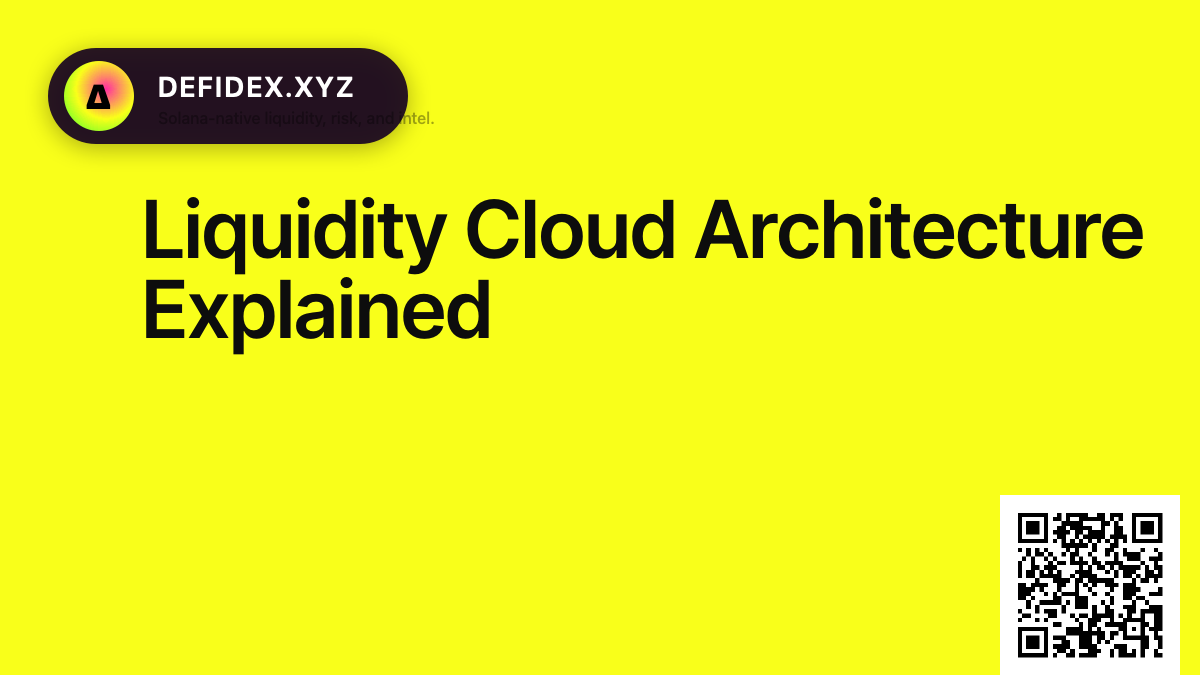Blog
Liquidity Cloud Architecture Explained

The Liquidity Cloud is our connective tissue. Every market you expose—spot, perps, RFQ—registers with a routing contract that understands where size lives, what risk class it belongs to, and which compliance rules govern it. Instead of bolting on new pools or crossing your fingers with third-party aggregators, you manage a single registry that points to every depth source, validates its heartbeat, and decides how much inventory it may commit. It is the difference between herding exchanges one by one and orchestrating them as an always-on ensemble.
A trader entering SOL-PERP should never care whether the size comes from an RFQ desk, an AMM vault, or a bilateral warehouse. They should only feel fast confirmations and predictable slippage. The Liquidity Cloud therefore homogenizes quotes. Each stream publishes depth, fees, health scores, latency, and available borrow. We normalize those metrics, feed them into a scoring engine, and let the router pick the best path in microseconds. Your team can even weigh certain dimensions—maybe you care more about maker rebates on Tuesday because funding is negative, or perhaps you shift flow to vaults seeded by strategic partners who deserve the revenue share.
Traditional liquidity aggregation stops at quoting, but DeFiDex extends into settlement and accounting. When an RFQ maker fills an order, the result flows through the same accounting ledger as an AMM fill, so risk teams view a single book. You can configure exposure caps per counterparty, instruct the router to back off after a series of rejects, or pre-hedge imbalances through CEX APIs without leaving the toolchain. The Liquidity Cloud therefore becomes an operational guardrail, not just a switchboard.
We also obsess over governance. The routing policy is stored as versioned YAML and can be tied to multisig reviews or DAO votes if you operate a community exchange. Every change logs metadata—who authored it, which markets were affected, and which simulated trades were used for testing. Auditors or LPs can replay those simulations and observe precisely how the router would have behaved. That level of transparency is rare in CeFi yet trivial on-chain.
Speed still matters. Our routing layer was designed for Solana, so cold-start decisions clear within 400–600 microseconds, and we keep RPC proximity top of mind by co-locating nodes with validator clusters. Retail UIs can subscribe to a lightweight WebSocket feed, while professional trading stacks hit our gRPC endpoints for deterministic state dumps. Because we feed the same canonical data everywhere, bots and humans act from a synchronized view of the market.
Inventory management becomes easier once you view liquidity sources as first-class citizens. Operators can mirror third-party inventory, seed internal vaults, or incentivize specific cohorts. Suppose a fund wants to provide deep liquidity at night to capture spreads. You can mint them a vault, set guardrails for quote width and risk, and stream their performance stats in real time. Should their metrics fall below threshold, the router gracefully winds down their allocation and replaces it with other makers.
Derivatives desks often worry about cross-margining and collateral fragmentation. The Liquidity Cloud addresses this by pairing routing logic with settlement adapters. If a fill originates from an RFQ desk that prefers USDC deposits on a different chain, the adapter instructs your treasury to rebalance accordingly, all while keeping user balances on Solana. From the trader’s perspective nothing changes—they still see an on-chain confirmation and their PnL updates instantly—but backstage the system can orchestrate bridges, borrow, and hedges to keep the overall platform solvent.
Finally, the Liquidity Cloud is programmable. You can plug in custom scorecards, inject AI hints, or create new venue types as new Solana primitives arrive. We have clients that prioritize eco-friendly validators as part of their ESG commitments, and others who prefer to keep 20% of flow on their own crossing pools for relationship reasons. The architecture embraces that individuality while guaranteeing best execution, compliance reporting, and 24/7 resilience.
If you zoom out, the Liquidity Cloud becomes a strategic moat. Institutions want measurable uptime, regulators want granular audit logs, and growth teams want white-label friendly APIs. This stack satisfies each stakeholder without forcing compromises. You can market deep liquidity because multiple venues participate, you can onboard partners quickly because routing rules are modular, and you can sleep at night because built-in telemetry screams before anything drifts. That is how you win in an era where traders compare every DEX to the most sophisticated CEX consoles, regardless of jurisdiction or asset class.
